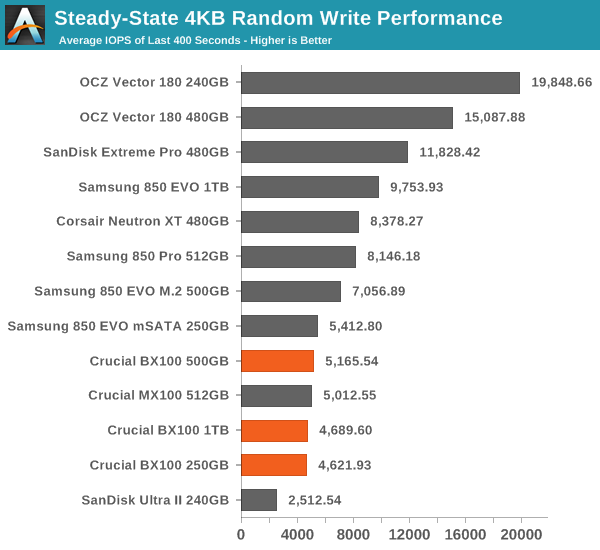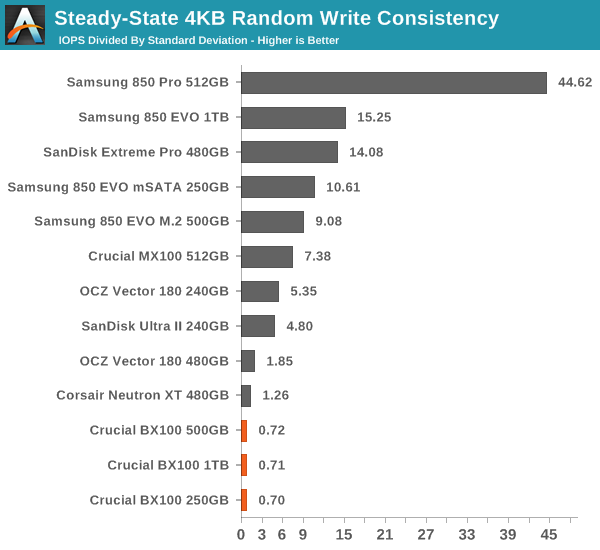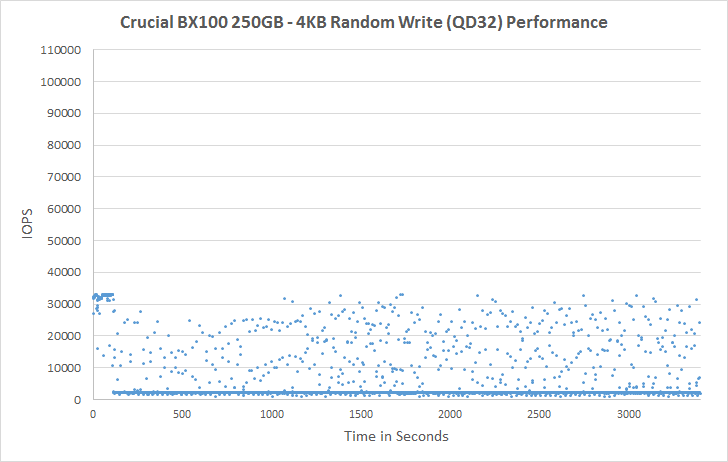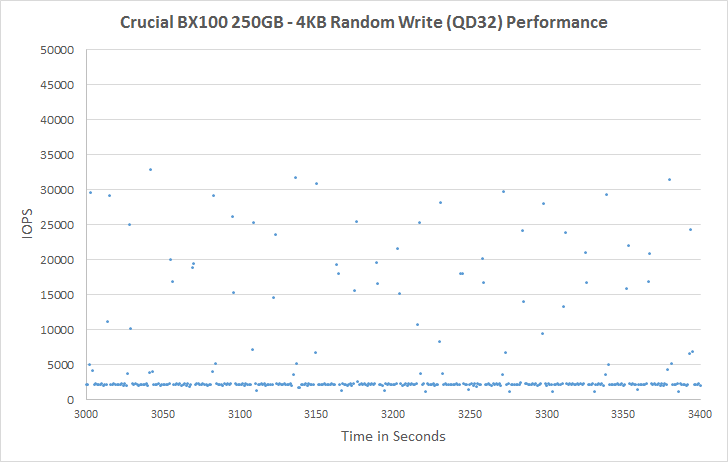Crucial BX100 (120GB, 250GB, 500GB & 1TB) SSD Review
by Kristian Vättö on April 10, 2015 1:20 PM EST- Posted in
- Storage
- SSDs
- Crucial
- Micron
- Silicon Motion
- BX100
- SM2246EN
- Micron 16nm
Performance Consistency
We've been looking at performance consistency since the Intel SSD DC S3700 review in late 2012 and it has become one of the cornerstones of our SSD reviews. Back in the days many SSD vendors were only focusing on high peak performance, which unfortunately came at the cost of sustained performance. In other words, the drives would push high IOPS in certain synthetic scenarios to provide nice marketing numbers, but as soon as you pushed the drive for more than a few minutes you could easily run into hiccups caused by poor performance consistency.
Once we started exploring IO consistency, nearly all SSD manufacturers made a move to improve consistency and for the 2015 suite, I haven't made any significant changes to the methodology we use to test IO consistency. The biggest change is the move from VDBench to Iometer 1.1.0 as the benchmarking software and I've also extended the test from 2000 seconds to a full hour to ensure that all drives hit steady-state during the test.
For better readability, I now provide bar graphs with the first one being an average IOPS of the last 400 seconds and the second graph displaying the IOPS divided by standard deviation during the same period. Average IOPS provides a quick look into overall performance, but it can easily hide bad consistency, so looking at standard deviation is necessary for a complete look into consistency.
I'm still providing the same scatter graphs too, of course. However, I decided to dump the logarithmic graphs and go linear-only since logarithmic graphs aren't as accurate and can be hard to interpret for those who aren't familiar with them. I provide two graphs: one that includes the whole duration of the test and another that focuses on the last 400 seconds of the test to get a better scope into steady-state performance.

Steady-state performance has never been Crucial's nor Silicon Motion's biggest strength, but 5K IOPS is fairly average for a value-oriented SSD and for the target group the performance is just fine.

As some of you have mentioned in the comments, displaying standard deviation alone isn't very useful because it totally ignores the IOPS, so I've changed the graph to IOPS divided by standard deviation during the last 400 seconds of the run. The SM2246EN has always been very inconsistent and it appears that the BX100 is no exception since it has the worst consistency we've tested so far.
 |
|||||||||
| Default | |||||||||
| 25% Over-Provisioning | |||||||||
Putting the IOPS under a microscope shows that the consistency really is poor. That's nothing new to the SM2246EN and the graph is very similar to the other SM2246EN drives we have tested, although I was hoping that Crucial would have tuned the firmware for better consistency. On the other hand, the users buying the BX100 are unlikely to put the drive under harsh 4KB random write workloads, so all in all the consistency isn't much of an issue.
 |
|||||||||
| Default | |||||||||
| 25% Over-Provisioning | |||||||||










67 Comments
View All Comments
SeanJ76 - Monday, April 27, 2015 - link
-and Crucial has the worst reliability record when it comes to SSD's, right next to OCZ, two of the worst SSD makers today.........that's why their so dirt cheap!MarkHunt - Sunday, May 3, 2015 - link
BX100 250GB running excellent on an old SATA 2 motherboard based C2D Hackintosh, the boot speed is incredible and applications such as Logic open with little lag, which used to happen with previous HDD. TRIM is also simple to enable with Clover bootloader.rogerdpack - Thursday, May 14, 2015 - link
unfortunately it appears the 120GB version has dramatically worse write performance, just a heads up, than its counterparts: http://ssd.userbenchmark.com/Compare/Crucial-BX100...kadajawi - Thursday, May 21, 2015 - link
Wait a minute. According to pretty much every other reviewer, news site etc. the power loss capacitors are missing from the BX100, yet Anandtech says they are there. What is it now? To me that's a pretty big deal, as I don't run my laptop with a battery and the power plug may occasionally slide out...LeonS - Monday, October 19, 2015 - link
Has anyone found a definitive answer for this yet? I have searched high and low, but cannot find an answer!sligett - Tuesday, June 16, 2015 - link
Are the idle power consumption labels switched for the BX100 250GB and 120GB?marvalsys - Monday, October 12, 2015 - link
Just spent way too much time trying to clone a 500GB WD hard disk with Windows 10 to a BX100 to use in a new Lenovo Flex 3 15". Clone went fine (booting from a True Image 2015 CD) but with cloned SSD installed laptop wouldn't boot / wouldn't even POST or allow booting from any other drive. Same exact clone to a Samsung 850 EVO worked flawlessly. Call to Crucial tech support resulted in rep saying that they have no current SSDs compatible with Flex 3 15 (even though their website lists 7, including the BX100). Seems to be some confusion - buyers beware!